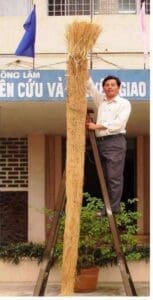This new book by Dr. Paul Truong provides a wealth of information on the function and unique role of the roots of vetiver grass that allow for a wide range of environmental mitigation.
Paul Truong, TVNI’s Technical Director, has been undertaking research and development of Vetiver System Technology (VST). He was fortunate to be located in Queensland, Australia, allowing him to research and apply a wide range of VST applications, under many different climatic and ecological conditions. He has also worked closely with VST researchers in other countries and as result can be considered the leading
“Vetiver” scientist. Without his work and leadership and his generosity in sharing the knowledge, VST would not be developed as it is today. He is especially recognized for the development of VST for phytoremedial applications for the treatment of contaminated land and water where Vetiver grass, especially its roots, stands out as prime technology for bio-remedial mitigation.
The book focuses on the unique characteristics of vetiver grass roots; and provides a detailed technical back drop to the author’s 30 years of work devoted to this plant.
Most people never give a second thought to the hidden parts of a plant, comprising the roots, and the microflora and fauna, and soil nutrients that interact with the roots. It is an exciting fact that vetiver roots are so unique – allowing the plant to multifunction in so many different ways resulting in a compendium of applications that no other plant can to the same extent emulate.
Vetiver’s root structure gives it the strength of 1/6 of mild steel and is stronger than those of trees. The roots contain many complex chemicals that are able, with some help from symbiotic arbuscular mycorrhiza, to process and absorb toxic chemicals and metals at levels that other plants cannot. Its root cells change and adapt under different conditions – it can survive under extreme drought and under three months of total submergence in water. It can survive and even flourish in extreme acid, alkaline, and saline soils. Those same roots create chemical pheromones that attract the stem borer moth to lay its eggs on vetiver leaves in
preference to crops like maize and rice, and then another chemical that is able to destroy the digestive enzyme of the larva of that moth – truly an amazing plant.
Most importantly these roots, and the supported leaves, provide communities of all sizes and cultures an affordable tool that can be used in a sustainable manner to combat the current threat of climate change – including the very destruction and health of the soils that we depend on for survival.
Amongst many applications, perhaps the most important one was the discovery of the value of the plant for phytoremediation of contaminated water and land – thus allowing for low-cost remediation of contaminated mining and industrial sites, and the treatment of polluted water. The latter is a major problem, particularly in developing countries, and vetiver provides an excellent low-cost solution when designed and applied correctly.
This book will undoubtedly enhance the Vetiver System Technology, a technology brought to our attention by John Greenfield 35 years ago, and since nursed and further developed by all 168 vetiver associates around the world for the betterment of tens of thousands of people across the tropical and sub-tropical world. Vetiver’s non-invasive, wide range of application, and cost-effective characteristics, provides the means for communities in developing nations some self-reliance where capital resources are scarce, and land and water degradation problems are acute and increasing.
This book is downloadable free from this website.
Gracias por permitirme participar.
Es la primera vez en años, que puedo accesar y concretar contacto, pues todas las veces anteriores, por deficiencia de señal, la conexión se perdía antes de validar mi correo. Conozco Vetiver y su cualidades desde hace una década y lo estoy usando, he hecho pruebas del comportamiento de sus raíces en varios tipos de tierra y agua, en vivero.
En agua es excelente! Sobrevive a 4 meses en agua estancada en tambores de plástico, sin más reposición que el agua de lluvia que recibía con cada precipitación, y el desarrollo de las raíces en agua de piscinas es sorprendente, llegando a mas de 50cm en 2 meses.
Lo uso en saneamiento ambiental, tratamiento de aguas grises y negras y en regeneración de suelos.
Lo más sorprendente para mí, que cuando llevado a campo, en huerta y alrededor de árboles frutales, el desarrollo de raíces fue mínimo, presentando un sistema radicular denso con raicillas entramadas que contuvieron muy bien la materia orgánica, pero extremadamente corto, alcanzando apenas 40cm en 2 años aproximadamente.
Esto fue realmente inaudito, pues tenía toda la información y referencia de TVNI, además de las propias observaciones en vivero.
Sin dudas esto resulta impactante para la comunidad Vetiver Internacional, tanto como lo fue para mí.
Esta experiencia, la compartí en la publicación “Regenerar la vida” https://nativayancestral.es/somos-semillas/
En el apartado, Experiencia Vetiver (Pag. 123-125)
El terreno en que lo experimenté, es un suelo arcilloso altamente denso, en la Provincia de Entre Ríos, Argentina.
Transcribo a continuación tal como lo describo en la página 103 de dicho libro,
” El suelo en esta zona es de color oscuro uniforme, que según la edafología de la provincia, presenta predominancia de Vertisoles, alta proporción de arcillas expansivas que se hinchan con el agua y contraen generando grietas profundas y anchas en temporada seca, lo cual le confiere un drenaje muy deficiente y a lo que comúnmente llamamos en la zona “tierra ladrillera”; esto conlleva a la formación de pequeñas pozas de agua superficiales, generando un relieve particular donde alternan pequeñas protuberancias y depresiones dispuestas en una geometría casi cristalina, conocido como “microrelieve Gilgail” (Foto 2)
La mejor descripción de este suelo y su topografía, la encontré en escritos de Ibáñez y Manríquez Cosio (1), “Dicho de otro modo, podría defenderse, metafóricamente, que tales edafotaxa se contraen y expanden, más o menos cíclicamente, como un corazón, al ritmo de las estaciones”. Probablemente estos señores nunca hayan estado en la Provincia de Entre Ríos, pero esa definición, explica nuestras observaciones “la tierra famélica, se lo come todo” “a los 15 días parece que nada le hubieras puesto”
Sabe Dios si por suerte o desgracia, nos ha tocado habitar este suelo, que compartimos con Australia, (especialmente Queensland, New South Wales), la meseta de Decán en India, sur de Sudán, Etiopía y Chad (la Gezira), ya que los Vertisoles predominan entre los 50° N a 45° S del Ecuador terrestre.”
“Regenerar la vida”.
https://nativayancestral.es/somos-semillas/
Esta experiencia, está registrada en imágenes, fotos y videos, que si me lo permiten y aceptan, quiero compartir, pues es un documento/registro inédito del comportamiento de las raíces de Vetiver en suelo arcilloso denso.
Muchas gracias.
Atentamente,
Luján Rodriguez.
Argentina